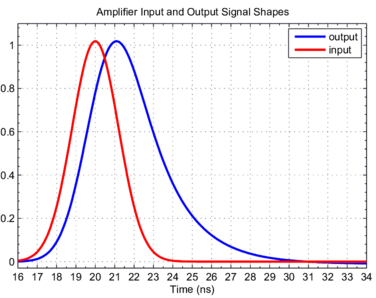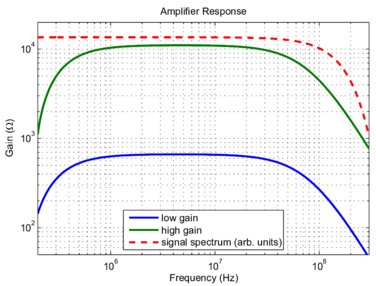SiPM Amplifier Signal Analysis
Since the tagging rate of the tagger microscope is set by the dead time of its sensors, shortening amplified pulses from the SiPMs is essential. However, a lower-bound requirement exists on the speed of the output signals: the ADC reading out microscope signals samples at 250 MHz.
Photonique, the manufacturer of the SiPMs adopted for this design, promises rise times <3 ns and cell recovery time <15 ns. The signal from the SiPM was measured with a laser diode - a device thought to have a negligibly fast response. The light source was driven with an electronic pulse barely over threshold to generate very short signals on the order of a few photons in intensity. Undoing the convolution due to the 200 MHz-bandwidth oscilloscope indeed yields a very short signal shown in the adjacent figure (smoothed and reasonably approximated by a Gaussian.) The shaping of this input signal by the modeled amplifier was then examined.
The speed of the amplifier response is one of the chief challenges. The transistors themselves, at a bandwidth of ~4 GHz, cover the expected signal spectrum well enough. However, points in the amplifier circuit where currents are injected present integrators with the RC time set by the effective AC coupling capacitance and input impedance of the following stage. Since reduction of effective capacitance at the SiPM circuit stage is not an option (the effective charge deposited per SiPM pixel discharge decreases) the input impedance was minimized. This is accomplished both in the amplifier and summing circuit input stages with injection on the transistor emitter (as opposed to base.) The effective resistance is thus on the order of 20 Ω (generally a quiescent current-dependent value) as opposed to a parallel combination of order 1 kΩ resistors and the effective βRE resistance looking into the base.
The spectral response of the modeled amplifier in its low and high gain setting (see SiPM Amplifier Optimization) is shown in Fig. 2. Note the beginning of the roll-off in the response (due to the integration described above) within the spectral envelope of the input signal. The stretching seen in the time-domain plot is due to this attenuation of high frequency components. However, given the ADC's sampling rate of 250 MSPs shortening the pulse further (flattening the frequency response across the entire signal spectrum) is not necessary.

